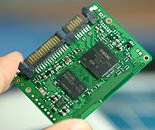Wednesday, August 27th 2008

Samsung Introduces High-Performance, Low-Density and Low-Priced SATA II SSDs
Samsung Electronics, the world leader in advanced semiconductor technology, announced today that it has begun sampling low-density, higher-performance solid state drives (SSDs) that are only 30 percent of the size of 2.5-inch SSDs and highly cost-efficient to manufacture. With the introduction of these smaller, low-capacity SSDs, Samsung now offers an attractive replacement for existing hard drives used in low-cost PCs. Available in densities of 8GB, 16GB and 32GB, the new multi-level-cell SSDs will be mass produced beginning next month."We've refined our manufacturing techniques and redesigned our low-density SSDs to get what the low-priced PC market is looking for in the way of improved cost, performance and availability," said Jim Elliott, Vice President, Memory Marketing, Samsung Semiconductor, Inc.
The low-density Samsung SSDs use the same high-performance SATA II controller technology as that being used on Samsung's just-introduced MLC-based 128GB SSD.
Samsung's new MLC-based SSD at 32GB capacity will read data (sequentially) at 90MB/s and write it (sequentially) at 70MB/s - performance levels much greater than low-density SSDs on the market today. The 16GB reads at 90MB/s and writes at 45MB/s, while the 8GB reads at 90MB/s and writes at 25MB/s.
Samsung incorporates four individual 16 gigabit (Gb) MLC NAND chips in its 8GB SSD, as well as four dual-die packages and four quad-die packages of 16Gb NAND for its 16GB and 32GB SSDs respectively. Furthermore, by including a 32MB DRAM as the buffer and four-channel system for the new low-density SSDs, these solutions are better suited for high-speed reading environments.
Samsung has expanded its SSD market offerings since it introduced its first SSD in 2006 in 16GB and 32GB capacities targeted at the Ultra Mobile PC market. This was followed by the announcement of the 64GB SSD in 2007, a 128GB SSD in 2008, and sampling of a 256GB SSD in the second half of 2008.
With increased sales of low-cost PCs and recent efforts by most major PC manufacturers to develop their own low-cost PC offerings, the market for lower density SSDs has been experiencing explosive growth. By unit sales, the low-density SSD market is expected to increase annually by 57% until 2011, with SSDs for low-priced PCs being the main driver of market demand.
Source:
Samsung
The low-density Samsung SSDs use the same high-performance SATA II controller technology as that being used on Samsung's just-introduced MLC-based 128GB SSD.
Samsung's new MLC-based SSD at 32GB capacity will read data (sequentially) at 90MB/s and write it (sequentially) at 70MB/s - performance levels much greater than low-density SSDs on the market today. The 16GB reads at 90MB/s and writes at 45MB/s, while the 8GB reads at 90MB/s and writes at 25MB/s.
Samsung incorporates four individual 16 gigabit (Gb) MLC NAND chips in its 8GB SSD, as well as four dual-die packages and four quad-die packages of 16Gb NAND for its 16GB and 32GB SSDs respectively. Furthermore, by including a 32MB DRAM as the buffer and four-channel system for the new low-density SSDs, these solutions are better suited for high-speed reading environments.
Samsung has expanded its SSD market offerings since it introduced its first SSD in 2006 in 16GB and 32GB capacities targeted at the Ultra Mobile PC market. This was followed by the announcement of the 64GB SSD in 2007, a 128GB SSD in 2008, and sampling of a 256GB SSD in the second half of 2008.
With increased sales of low-cost PCs and recent efforts by most major PC manufacturers to develop their own low-cost PC offerings, the market for lower density SSDs has been experiencing explosive growth. By unit sales, the low-density SSD market is expected to increase annually by 57% until 2011, with SSDs for low-priced PCs being the main driver of market demand.

12 Comments on Samsung Introduces High-Performance, Low-Density and Low-Priced SATA II SSDs
if it's slow and cheap i will use them in my surfmachine :laugh:
slow and expensive :slap:
so far i love the idear of no moving parts :roll:
All though it all so means when you buy a HDD it's going out of date much much sooner as speed of them will rocket.
I just hope these will make good OS/Boot drives and leave everything else to what we choose to use. That would be sweet. "So what chip (OS) do you have plugged in now."
but that would be cool
Any idea about the price?